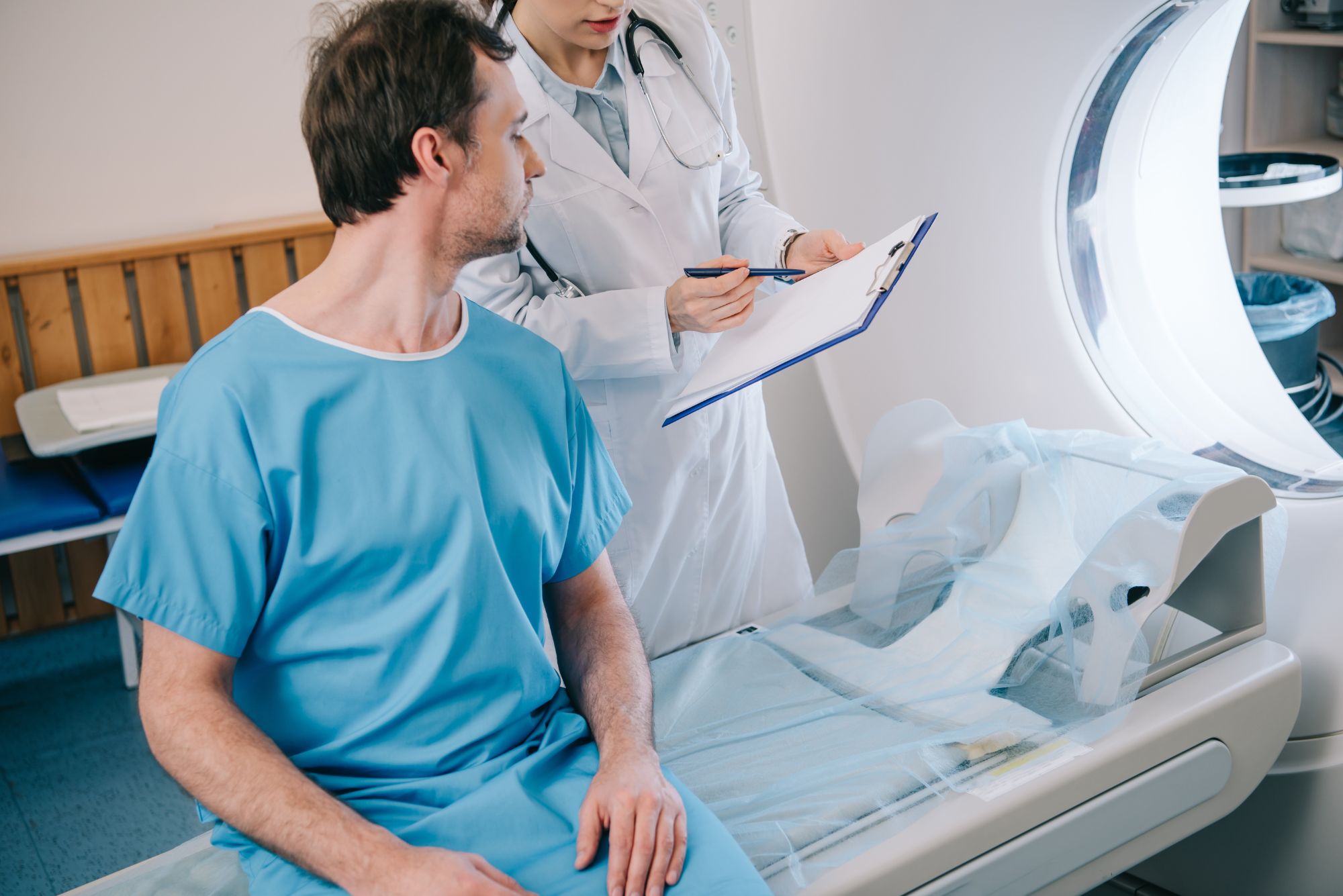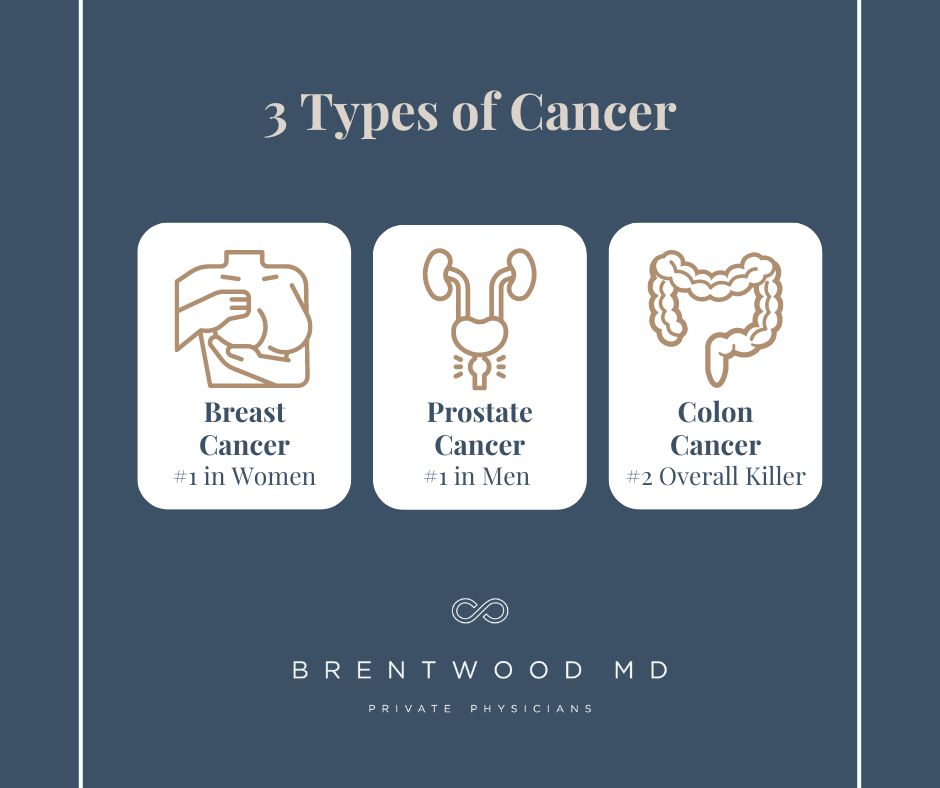Download file | Play in new window | |
At Brentwood MD, we talk a lot about the latest and greatest options for health care. In fact, just a few months ago, we did a series rethinking old ways of cancer screenings and evaluating new ones, like GRAIL testing.
But even after discussing all the amazing new developments in cancer testing, I felt it was important to come back and cover the existing cancer screening options we all already have right in front of us.
Here, my fantastic podcast copilot, Jen Justus, and I review the basic screening tests you need to get for three of the most common cancers: breast, prostate, and colon. These tests are readily available, inexpensive, and don’t require a fancy concierge service.
And the best part? They can literally save your life.
Breast Cancer
Breast cancer is the most common cancer in women in the United States — more prevalent than ovarian, uterine, and lung cancers. About 13% of all women born in the U.S. will be diagnosed with breast cancer in their lifetime. That means for every 10 women you know, one to two of them will have to deal with a breast cancer diagnosis.
Last year alone saw 290,000 new cases of breast cancer and 43,000 breast cancer deaths — moms, wives, sisters, neighbors, friends. Breast cancer makes up about one in three of all new female cancers each year.
The case numbers of breast cancer will rise as more people get their screenings, but the hope is that mortality rates will correspondingly drop. The reason? Timing is everything.
Nobody wants to find cancer, but if you’re going to get it, finding it early will give you more time to evaluate, think, explore your options, and start treatment. If you can catch cancer early, you dramatically increase your odds of beating it. This is what makes scheduling your screening tests on time and following through with them so important.
When you find cancer late, you have to make decisions on a much tighter runway. And for many women who find breast cancer late into its development, there’s no runway at all.
What to Know About Breast Cancer Screening
There are several options for breast cancer screenings, and you’re probably already familiar with some of them. For example, mammograms are X-ray pictures of your breast tissue that show any tumors or abnormalities. Mammograms are low cost, covered by insurance, take very little time, and are a great place to start.
If the screening detects anything suspicious, you’ll move on to a more diagnostic mammogram, possibly a biopsy, or maybe even a breast MRI, depending on your situation. If you have very dense breast tissue, sometimes an MRI provides a better picture of what’s going on. Another option that’s becoming more common is the 3D mammogram, which shows a bit more detail.
As for the timing recommendations for breast cancer screening, everyone has a different opinion. Seriously. The American Cancer Society, American Association of Family Physicians, and the CDC all have different recommendations for how often you should be screened.
This is where our practice differs: We’re not doing population health. We can use these guidelines to help us, but we also consider your family history and your specific risk factors to determine when you should start your mammograms.
We typically recommend you start annual screenings at age 40. But if you have a mom or an aunt who had breast cancer, you’ll want to start screenings at least 10 years before their age of diagnosis. If you know you have the BRCA genes that are commonly linked with breast cancer, you should start screenings a bit earlier. Factors like smoking and obesity can also raise your risk and prompt earlier screening.
Though they’re not nearly as effective as mammograms or other more advanced testing, self breast exams can be invaluable. This is true especially if you haven’t yet reached the age for regular mammogram screening and/or if you consider yourself to be pretty body aware. There are countless women alive today, including my wife, because they detected something suspicious in a self exam.
However, self exams aren’t a replacement for annual screenings. Mammograms can detect cancer up to three years before you can actually feel it in a self exam.
One final important note on breast cancer: men aren’t exempt. Men actually have breast tissue, and though male breast cancer isn’t common, it is possible. Staying body aware and taking note of any suspicious lumps or bumps will help spot breast cancer in men.
Prostate Cancer
By far, the most common cancer in men is prostate cancer. There were 268,000 new cases of prostate cancer last year, and about one in eight men will be diagnosed with prostate cancer in their lifetime.
If men live long enough, they’re likely to develop prostate cancer at some point. But if you don’t develop prostate cancer until your 80s, it’s unlikely to create problems. In fact, most urologists will leave it alone. At that age, you’ll likely die with prostate cancer, but not from it.
The prostate cancers that tend to cause bigger problems are those that develop in men in their 40s or 50s. These are often more aggressive forms that show up early and take off.
Thankfully, we have a pretty good grasp of how to deal with prostate cancer — how to identify it, early indicators, and how to treat it to get good outcomes. But again, this is why timely screenings are so important.
Regular screenings mean you catch prostate cancer early enough that you simply need your prostate removed. That’s a far cry better than catching it late, after the cancer has spread. You’ll still need the prostate surgery, but you’ll also need additional treatment, and the outcomes can be much worse.
What to Know About Prostate Cancer Screening
There’s a huge misconception in the male community about prostate health. Everyone’s afraid of prostate cancer and knows they don’t want it, but very few younger men in their 40s and 50s are getting their prostate checked because they think they’ll have to get a digital rectal exam.
The thing is, while a digital rectal exam still has a place at times, it’s not the ideal screening mechanism for prostate cancer. It’s very subjective, operator dependent, and just not reliable. It’s not something I recommend for a diagnosis — for myself, or for anyone I care for.
Instead, we do a prostate-specific antigen test, or PSA test, for our screenings. PSA is a very sensitive inflammation marker we can measure from a simple blood draw. You don’t even have to fast beforehand.
The PSA test is sensitive for everything and specific for nothing, which means anything going on with your prostate will show up on the test.
In our world, if there’s an adult man who’s coming in for care, we’re getting him an annual PSA test for a baseline. The more data points I have from years of regular baseline testing, the better optics I have to understand the context of your PSA test and make evidence-based decisions. I recommend every man age 40 and over get a baseline PSA, because the following two decades are when early prostate cancers that are aggressive enough to kill are more likely to show up.
Population health stats say PSA results lower than 4 mean no cancer, but we know all too well that isn’t always the case. It’s a reasonable recommendation for population health, but I’d suggest the rate of rise year over year, not the absolute value, matters exponentially more when determining if further testing is needed. A man who goes from a 1 to a 2.5 may still be under the official threshold, but that level of increase merits some investigation.
If there’s an elevated PSA, traditionally the next move is a prostate biopsy. That’s the protocol, it’s what insurance pays for, and it’s what a lot of men get.
But it’s not what we do. Because the PSA test is non-specific, it can lead to some needless biopsies, which no man wants to go through. So first we order a prostate MRI because an MRI can show — down to about a millimeter of detail — whether there’s something that looks suspicious.
Often we find it’s just BPH (benign prostatic hyperplasia, a.k.a. a swollen prostate) that’s firing off some PSA, and sometimes it’s an infection called prostatitis that can be treated with antibiotics.
However, if the MRI shows a suspicious lesion, that’s when we move to a biopsy.
Factors That Could Influence Recommendations
Not all cancers are created equal. If your biopsy does show cancer, the pathologist will also assign the tumor a Gleason score, which tells you how aggressive the tumor is, based on the characteristics the pathologist sees.
The higher the Gleason score, the more aggressive-looking the tumor. We tend to find that prostate cancers occurring earlier in life have higher Gleason scores.
Outside of age, which is the greatest risk factor, family history is a strong indicator of your likelihood of developing prostate cancer. While certain behaviors could potentially increase people’s risk in general, many thought leaders in this space believe there isn’t much you can do to raise or lower your risk of developing prostate cancer if you’re already predisposed to it.
So if you develop prostate cancer, it’s not because you’ve done something wrong. But this is a major reason why we need to keep an eye on things.
Colon Cancer
The good news is that dying from colon cancer should be pretty uncommon. It’s a slow-growing cancer, and if you’re doing your screening tests, you’ll catch it pretty early.
The keyword here is “should.” Unfortunately, in general, very few people are being adequately screened. This is a major problem.
In reality, colon cancer is the number two cancer killer on the planet.
What to Know About Colon Cancer Screening
Monitoring for breast cancer often starts with your primary care physician and a mammogram order. Monitoring for prostate cancer also typically starts in primary care with a PSA test. But to test for colon cancer, you have to see a gastrointestinal (GI) doctor first, and looping in a specialist, getting a consult, and scheduling the test separately makes things a little more cumbersome.
Traditionally, the gold standard screening test for colon cancer is a colonoscopy. Nothing compares to looking all the way throughout your colon to get a clear idea of what’s going on.
Colonoscopy screening recommendations used to start at age 50, but we were encouraged when the age was reduced to 45. If your colonoscopy comes back clear, you don’t have to do another one for 10 years, and you get to stop at age 75. So if you do the math, most people will only have three colonoscopies in their lifetime.
One of the biggest benefits of colonoscopies, and a major reason they’re still the gold standard, is they aren’t just for looking around.
All colon cancers develop from polyps, though not all polyps turn into cancer. During a colonoscopy, the GI doctor snags off any polyps present in the colon, removing potential origin sites of cancer. They then test those polyps to see if any are already cancerous. If they are, you’ll simply need to come back for another colonoscopy in five years instead of 10.
Some people are strongly against getting colonoscopies, whether it’s because the test seems unpleasant or they have a medical issue. For anyone in this category, I’d encourage you to make sure you’ve really considered the matter thoroughly. A single colonoscopy puts you in the clear for a decade and dramatically reduces your risk.
If you’re still not on board for a colonoscopy, there are a few other options that provide some level of screening:
- Flexible Sigmoidoscopy (Flex Sig): Done in an office without sedation every five years, a doctor uses a flexible scope to examine the bottom portion of the colon, where most colon cancers develop. If you don’t tolerate anesthesia well, this could be a good alternative to a colonoscopy.
- Virtual Colonoscopy (CT Colonography): Computed tomography (CT) scans create a virtual map of your colon. This is a newer technology and should be done every five years.
- Stool and Blood Studies: Tests like Cologuard, GRAIL, and Shield are available from your primary care physician and look for DNA of cancer cells in stool or blood that could indicate colon cancer.
While studies show these tests are effective at detecting cancer, you have to do them every year. This technology also doesn’t detect or address polyps. And by the time it detects cancer, you’ll need to move fast. However, it’s a nice screening tool to bridge the gap if the logistics of coordinating a full colonoscopy just aren’t feasible at the moment.
Risk factors that influence the likelihood of developing colon cancer and which can affect the timing of your colon screenings include:
- Traditional Western diet (high in processed foods and low in fiber and nutrient-dense foods)
- Smoking
- Obesity
- Overindulging in alcohol
- Inflammatory bowel disease (like Crohn’s or ulcerative colitis)
Get the Time-Tested Screenings
Here’s the bottom line: Don’t overlook the things that are right in front of you, are readily available, and aren’t cost-prohibitive.
While we’re very excited about fancy new screening options, they aren’t replacements for the standard screenings we’ve discussed. We have really great techniques that can help you avoid bad outcomes from breast, colon, and prostate cancers. Unlike some other diseases, these cancers just aren’t all that preventable.
Our best chance is early detection, and these tests are our top tools.

Dr. Aaron Wenzel is a concierge physician specializing in the care of fast-moving entrepreneurs, executives, and public figures in the Nashville, TN area. Dr. Wenzel’s diverse life experience and extensive training in family medicine, emergency care, nutrition, and hormone replacement therapies give him the unique platform to provide unmatched care for his patients.








